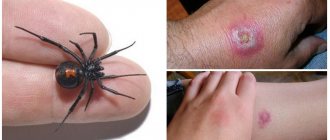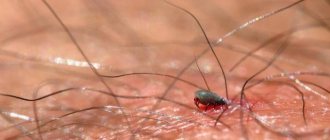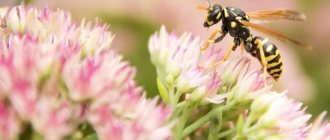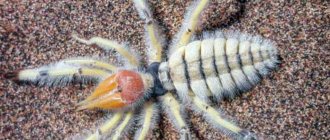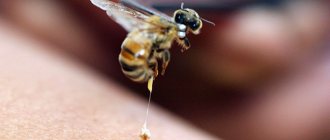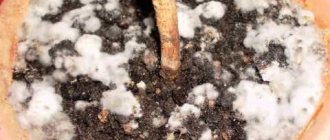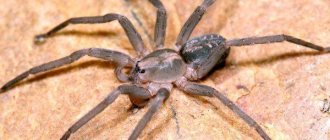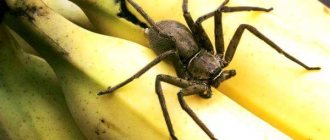Appearance of a burrowing wasp
The sizes of burrowing wasps vary: the body length of different species can reach 2-55 millimeters.
The pronotum in the upper part looks like a roller, which is a distinctive feature of this group of wasps.
Because burrowing wasps dig into the ground, they have hard, ridge-like scutes on their front legs that act like a shovel when pushing back the soil. But it is worth noting that not all wasps of this group settle in the ground; some representatives prefer wood or plant stems.
In many burrowing wasps, the apical segment looks like a flat platform, since wasps use such segments to pull out soil and level the walls of passages.
Features of reproduction
After fertilization, the female begins building a nest for the offspring. One egg is laid in each clay capsule filled with spiders. The entrance is closed with a lid made of substrate. This is where contact between mother and offspring ends. The larva has a white worm-like body, completely different from the slender pelopei. The offspring are inactive and defenseless against any danger. Their limbs are reduced. The larva grows and develops by eating reserves. The small head consists almost entirely of jaws.
Paralyzed but living spiders serve as a source of protein until the larvae mature and pupate. From 5 to 10 different spiders are placed in a cell. Among the victims there are dangerous species, but the dexterous wasp instantly paralyzes the prey with a sting strike to the nerve center. The embryo develops in the egg for 3-4 days. The larva feeds for 2 weeks, then makes a cocoon. At a young age, she can be in a state close to diapause for a long time. This allows you to survive low temperatures and other unfavorable conditions. After the situation changes, development resumes. Young pelopeis eat their way to freedom at the end of June. Overwinters in the pronymph stage.
Interesting fact. Among all members of the family of burrowing wasps, female pelopeas are considered the most skilled nest builders.
One of the reasons for the reduction in the number of scelyphrons is the low survival rate of offspring. During her life, the female lays 15-20 eggs. Some nests are washed away by rain and snow. Insects in destroyed cells become easy prey for rodents. Among the natural enemies of the pelopeia are the gloss wasps and the German wasps. They enter the nest and lay eggs in the formed cocoon.
Lifestyle
Ammophila has been studied more and better than other relatives. Leads a solitary lifestyle, does not build multi-tiered nests, and does not form a wasp society of working individuals. Each female is sexually mature and lives separately from the others. Insects do not communicate with signs, do not convey warnings to each other. In behavior, the burrowing ammophila wasp is calmer, reproduces its offspring slowly, and begins to lay eggs not with the onset of spring, but in the summer.
The mission of the adult is to search for a potential victim in order to lay an egg in it. Each species chooses a specific type of prey; ammophila preys on cutworm larvae. Finds them underground, paralyzes them into a nerve node, immobilizes them. It drags it into a hole that the female has prepared in advance for the larva. Lays an egg on the body, closes the entrance, and covers it with earth.
After 3-4 days, a larva crawls out of the egg and gradually begins to eat the victim. After 14 days it completes its development cycle and pupates. It spends the winter in this position. In spring, the imago emerges from the cocoon and crawls out. Mating occurs, after which the female begins to hunt for cutworms and lay eggs. Only one generation develops per year.
On a note!
The burrowing wasp is widespread; about 10 species live in Russia. It is found in forests, fields, orchards, vegetable gardens, and summer cottages. Unique species - bee wolf, Larra amathena, ammophila, sphex.
Wasp Ammophila
Ammophila, which translates to sand-loving wasp, is a familiar burrowing wasp that builds burrows in dry, barren soil. Ammophila is easily recognized by its long slender body, usually black, with a conspicuous red or orange-red patch at the end of its extremely narrow abdomen. This skilled digger uses two sets of tools: powerful, pointed mandibles, with which the wasp bites into the soil to loosen it, and front legs with peculiar brushes made of hard bristles, with which the wasp rakes away lumps of soil.
There are never any traces of excavation left around the nest. The wasp squeezes lumps of soil between the head and chest - so to speak, under the chin - and carries them to the side, flying ten centimeters away from the mine. Having dug a vertical shaft approximately the length of its body, the wasp makes a spacious chamber at the bottom, where it will place several caterpillars and its own offspring. Although this requires taking out a lot of soil and moving it aside, taking a few grains of sand each time, building a nest takes only about 45 minutes for the ammophila.
Then the female goes in search of prey, but before leaving, she closes the nest and masks the mouth of the burrow with lumps of earth, pebbles or twigs. Having caught a caterpillar, sometimes larger than itself, the wasp drags the prey to the nest, only in some places it manages to fly a little. Among the many nests, the female confidently finds hers, opens it and drags the prey into the chamber. She then lays a single egg on the caterpillar's body and seals the nest. This time, the wasp not only closes the entrance to the burrow, but also throws sand and gravel on it and levels the surface so that it is completely impossible to find the entrance.
The diligence and dexterity of the ammophila have long attracted the attention of naturalists, but only relatively recently two Dutch entomologists, who studied this wasp in detail, discovered one amazing feature of its behavior. They noticed that, having sealed a nest, the female can begin building the next one or open a nest built earlier
This in itself is unusual - most solitary wasps do not return to their sealed burrows. Researchers also learned that sometimes the female, on a second visit, only inspects the nest, and sometimes, having inspected it, flies away and returns to the nest, but with prey: she delivers a fresh supply of food for the larva, which has already eaten the first caterpillar. After replenishing its supplies, the wasp seals the nest and leaves it alone for several days. Meanwhile, she continues working on the third nest, inspects the second, and then returns to the first again, adds a few caterpillars to it and finally seals it. In this case, the ammophila not only blocks the entrance to the nest with pebbles, but also uses its head, like a hammer, to forcefully drive them into place. Sometimes she even grabs a pebble with her mandibles and rams the soil with it - one of two known cases of the use of “tools” by insects. Now the nest is tightly sealed, the female has done everything necessary for her firstborn - providing him with enough provisions for him to complete his larval stage and pupate in a protected burrow. Then the ammophila replenishes supplies in the second nest, finishes accumulating provisions in the third, and sometimes begins to build a fourth.
So, it turns out that this little wasp is simultaneously caring for at least three nests at different stages of development. She quickly finds each nest, although they are all camouflaged and surrounded by many of the same nests. She also knows when to visit which nest. After each visit, the wasp obviously remembers exactly what needs to be done: where to lay an egg, where to close up an unfinished hole, where to bring the next portion of caterpillars for the growing larva. Moreover, the wasp knows where to bring one caterpillar, where to bring several, and where to bring nothing. The information the wasp receives from a given nest is stored separately from the information it receives from other nests. The female usually visits the nest that is most in need of replenishment of food supplies; Apparently, she receives incentive from him to search for caterpillars. By immediately visiting another nest, she may receive a completely different stimulus there and yet will not forget either the location of the other nests or their needs.
Nesting site
As a rule, burrowing wasps (photos of some of them can be seen in this article) nest where it is safe. They dig holes for themselves in the sand, soil, and nest in the bark of trees or the stems of large plants. They do all this, following instinct, for future offspring. At the end of spring, burrowing bees begin their mating season, after which the insects lay eggs in a prepared nest.
Nest building process
The house for the offspring consists of elongated cells 3 cm long. Each of them is built and then filled with prey. Only then does the wasp begin building the next cell. Construction takes 1-2 days. The female has to make 12-15 flights to bring the required amount of dirt. After all the cells have been constructed, the nest is covered with an additional layer of dirt.
Spiders are placed in a special way; large and hard specimens are placed closer to the exit. The larva will have time to grow and get stronger before it gets to them. The wasp carries its prey through the air. She drags the first spider, backing away. An egg is laid on it. The rest of the pelopei are pushed into the hole. Over the course of a year, several generations can change. Summer offspring will grow in 30-40 days.
Information. The common pelopei does not show aggression towards humans. The insect is useful by catching spiders and other pests.
Real wasps.
True or folded wasps (family Vespidae) include species with a highly developed social organization.
The latter are perhaps the best known: painfully stinging insects with intrusive and often aggressive behavior, such as hornets. However, this family also includes small solitary forms, and in social taxa one can observe different levels of colony organization, allowing one to judge the evolution of sociality. From the latter point of view, pill wasps (Eumenes) and closely related wall wasps (Odynerus) belong to primitive forms. Most of them are single. Each female builds her own nest and places a “one-time allowance” for the larva in it. Pill wasps make small pitchers out of clay, attaching them to tree branches. Each of them has one camera. Wall wasps usually nest in the soil, but sometimes use abandoned nests of bees and other wasps, hollow branches, or even nail holes. Inside they place small caterpillars - usually several in each larval chamber. Eggs are laid on prey or suspended from the roof of the cell while food has not yet been prepared.
When there are a lot of caterpillars around, a related species, Synagris spiniventris, distributes “one-time allowances,” sometimes loading up to 60 tiny victims into the larval chamber. However, when it is not easy to find prey, the wasp gradually brings food to the larva until it is convinced that there is enough of it (by this time the larva usually has time to grow to 3/4 of its maximum size), then seals the nest and begins to build a new one.
The species Odynerus tropicalis always feeds its offspring gradually; the female daily brings small paralyzed caterpillars to the larva until it has fully developed, after which it seals the nest and leaves it to pupate alone. Thus, caring for the offspring continues almost the entire time it is able to eat, which is why this wasp is called “semi-social” (subsocial).
Representatives of the subsocial genus Zethus behave the same way, but their nests are more similar to those built by real social wasps. They mold it from chewed pieces of leaves and moss, so that the walls resemble paper. Some species of Zethus have been reported to feed their larvae with already lightly chewed caterpillars, and one species of the genus Synagris feeds its offspring directly on a daily basis with a mush of chewed caterpillars.
Diet of burrowing wasps
Adult burrowing wasps feed on plant sap, nectar, and the sweet secretions of certain insects, such as aphids. Some burrowing wasps drink water. And certain species squeeze out the collected nectar from the crops of bees.
Burrowing bees consume nectar and plant sap.
Nutrition
The sand wasp is a harmless and even useful creature. It feeds on plant nectar, juices of ripe fruits, vegetables, and water. Spends the night among grass and trees, clinging with its paws and jaws to a blade of grass, a leaf, or a twig. Wakes up with the first rays of sunshine.
On a note!
Hunting for armyworm larvae brings significant benefits to humans, since caterpillars are serious pests of many agricultural crops. They even eat supplies in barns.
Reproduction of burrowing wasps
All burrowing wasps show care towards their offspring. Adults build nests for the new generation, and prepare food for the larvae. The larvae feed on insects, such as caterpillars, spiders, butterflies, flies, and the like.
Each type of burrowing wasp selects certain insects as victims. They show amazing skill in hunting - they deliver fatal blows with precision. When the sting is pricked, the prey is paralyzed and does not deteriorate for a long time. Burrowing wasps paralyze their prey with their poisonous sting.
Burrowing wasps are solitary insects; they do not depend on other individuals, but take care of their offspring independently. When the female digs a hole and fills it with supplies, she lays an egg in it. She closes the hole with a plug made of substrate.
Some species exhibit even more complex behavior. Females check the nest daily and replenish it with fresh prey as the larvae consume the supplies. One female can monitor several nests at the same time.
There are quite a large number of species of burrowing wasps. Let's look at the most famous ones.
Weaknesses of OS
Despite their high defensive ability and propensity for public defense, wasps have weaknesses. They have many enemies. The main ones are parasitic neighbors. Who are these enemies?
- Wasp hives are home to a large number of mites, various beetles, and even other types of parasitic wasps. Their food base is larvae. Due to the fact that these parasites are small in size, have excellent camouflage and a sting, they skillfully protect themselves from working individuals.
- Although the flight speed of wasps is not so low, it is far from a record for the class of insects. It does not make it possible to avoid the fate of becoming a delicacy for wild animals - bears, wolverines, hedgehogs. Moreover, for them wasp stings are not an obstacle to eating.
- Wasps become a favorite treat for many birds. Buzzards are especially distinguished in this. They track their prey over several hundred meters and catch it in flight.
Sandy ammophila
These wasps have slender black bodies with bright red bellies. These are quite large wasps - they can reach 4 centimeters in length.
Sandy ammophila is one of the largest representatives of the family.
Sandy ammophila feeds its larvae with cutworm caterpillars living in the ground. The wasp finds the victim, drives it to the surface of the earth, paralyzes it and drags it to its burrow, and the victim is several times heavier than the wasp. The female drags the moth caterpillar into the nest, lays an egg on it, and then closes the hole and masks the entrance to it.
What are wasps afraid of?
Wasps have accompanied human homes for centuries, and the question still remains open: “What are wasps afraid of, and how to get rid of them using folk remedies?
The only clear answer is that wasps are afraid of fire. However, using open fire indoors is completely unsafe.
You can also try treating the wasp nest with boiling water. Again, this needs to be done at night. If you carry out such an event several times, then some of the wasps will die, and some will leave.
When figuring out what wasps are afraid of, you can use folk remedies, but not a single one of them is effective. For centuries, nature has taught wasps to survive and find food for themselves and their offspring. A person does not yet know how to outwit an insect, so he is forced to use chemicals. When dealing with wasps, try to be careful. Use proven methods, and certainly protective equipment.
If there are children nearby, do not take risks by using chemicals yourself, contact a professional service, they are guaranteed to cope with the task, because their chemicals and protective equipment are much more effective.
Philanthus - bee wolf
Philanthus is one of the types of burrowing wasps. It is a rather large and strong insect, measuring from 12 to 15 mm. Has a too large head compared to the body and strong jaws. The chest of the philanthus is black, the abdomen is bright yellow, and there are from one to three white stripes on the back. They called him the bee wolf because he attacks honey bees.
This happens as follows. The philanthus rushes at the bee when it, unsuspectingly, collects pollen from a flower. Having grabbed it with its paws, the bee wolf stings the victim in the neck and kills. Rhythmically moving his paws, he squeezes out the nectar collected by the bee from the bee's crop, which he licks with his tongue. Then the bee carries the completely empty bee back to her burrow to use it as food for her offspring.
Philanthus can cause serious harm to beekeepers if it settles next to the hives, since the bees stop flying out for honey and sit in the hives. The queen bee stops laying eggs and the colony gradually weakens. Paper wasps differ in the way they build their nests.
The road wasp lays larvae in the body of the spider. Read about the peculiarities of life and behavior of this wasp species here.
Are you already tormented by wasps that won’t let you live in peace? Find out how to make a trap for these insects using this link https://stopvreditel.ru/doma/sredstva/lovushka-dlja-os.html.
Several varieties
For the most part, all representatives of burrowers are loners. There are several of the most famous ones that are found on the territory of the Russian Federation.
Larra Anafemskaya
Larra Anafemskaya.
Single black with a brownish transition on the abdomen. She is the gardener's ally in the fight against the mole cricket. The wasp very accurately finds her, drives her out of the ground and stings her several times to paralyze her.
The mole cricket remains paralyzed for another 5 minutes, during which time the wasp lays an egg. Then the pest lives its own life; after pupation, it parasitizes the living mole cricket outside for some time, and it dies only immediately before the larva becomes a pupa.
Ammophila
This is a relatively large solitary sand wasp. She has thin long legs, a thin belly of black and red color. This wasp lays eggs on the surface of the larva, and the cutworm then drags the larva into its hole.
Ammophila.
Philant
Another name for this subspecies of burrowing wasp is bee wolf. This is a large insect that is a pest of honey bees. Philant catches the bees that collect nectar on the fly and kills them. Then he squeezes the crop to squeeze out the nectar. The devastated bee becomes food for future offspring.
Philant —Is it dangerous for humans?
Burrowing wasps are less poisonous and dangerous when compared to paper wasps. Ammophila bites people extremely rarely. This happens most often in cases of urgent need. Usually these insects prefer to hide unnoticed from human eyes. Ammophila does not transmit signs to other relatives, so there is no risk of an attack by a whole swarm.
She uses the sting for the purpose of self-defense when she is accidentally pressed on , stepped on or pressed against her. The ammophila will not be the first to attack or bite. The burrowing wasp does not form cocoon-shaped nests, so it has nothing to protect. And if a person accidentally steps on the place where the larva with the victim is hidden, then he will not be able to damage it, since it is located at a great depth.
After a bite, a standard allergic reaction develops.
It usually goes away on its own after first aid is provided to the victim.:
- Inspect the wound to identify the sting remaining in it. Usually it does not remain in the wound, because, unlike bees, it is firmly attached to the abdomen and there are no notches on it. It can remain on the victim only if the burrowing wasp was killed during the bite. If a sting is found, it is carefully removed.
- The wound is washed with any antiseptic (hydrogen peroxide, potassium permanganate solution, chlorhexidine solution). After treatment, apply an ice compress to the bitten area. This manipulation allows you to slow down the absorption of the toxic substance. Some try to squeeze out the poison, but this should absolutely not be done. Due to such actions, an infection can be introduced, which will provoke the development of an inflammatory reaction.
- If a person has been stung in nature and there are no disinfectants at hand, then you can use a plantain leaf. It is pre-washed with water, kneaded and applied to the wound. Dandelion leaf is also suitable for these purposes.
- The stung person is provided with complete peace of mind and is also given plenty of fluids to drink. Water or warm sweet tea will do.
- It is advisable to take antihistamines (Cetrin, Loratadine, Suprastin), which will prevent the development of an allergic reaction. You can also apply an ointment with antihistamine components locally.
The listed actions are appropriate if the bite is single. If the insects have made multiple bites, as well as if the neck, tongue or larynx are injured, then you should immediately call an ambulance. The same should be done if a wasp has bitten a baby. Children are at increased risk of developing a serious allergic reaction due to a weak immune system.
Most often, the burrowing wasp does not pose a danger to humans and is also useful for gardeners. This is a special species of Hymenoptera that occupies a special place in the ecosystem.
If a wasp bites
As statistics show, the peak of wasp stings occurs in the summer months of July and August, when there are many flowers everywhere, as well as a large number of ripe sweet fruits and berries.
Benefits and harms
Almost all species from the group of burrowing wasps bring undoubted benefits to gardeners, since in order to feed their offspring they destroy dangerous pests.
The exception is the Philanthus wasp, which was described above, due to its passionate love for bees.
If a wasp bites
As statistics show, the peak of wasp stings occurs in the summer months of July and August, when there are many flowers everywhere, as well as a large number of ripe sweet fruits and berries.
What to do if bitten by a wasp?
- First of all, it is necessary to examine the wound for any sting remaining in it. Most often, it does not remain in the wound, since, unlike bees, it is securely attached to the insect’s abdomen and does not have any jagged edges. The sting may remain in the wound if the wasp was killed during the bite. So, if a sting is found, it must be carefully removed.
- Then you need to wash the wound with any disinfectant solution, for example, hydrogen peroxide, a solution of potassium permanganate, diluted ammonia or even iodine, brilliant green. After treatment, it is necessary to apply an ice compress to the wound, this will help slow down the absorption of the poison. Under no circumstances should it be squeezed out, as it can introduce an infection into the body and provoke the development of inflammation.
- If disinfectants are not at hand, you can apply a plantain leaf, previously washed and thoroughly mashed, to the wound. A dandelion leaf will also work.
- The victim should be provided with plenty of fluids. To do this, you can give him warm sweet tea or water.
- If possible, you should definitely take antihistamines to prevent the development of allergies.
All of these recommendations are appropriate if a person has suffered from a single bite.
In case of multiple bites, as well as if the neck, tongue, or larynx are injured, you should immediately consult a doctor!
Consequences of wasp stings
A wasp sting is a modified ovipositor. But when attacked, the insect uses it as a weapon.
When bitten, a toxin is released into the skin through the sting, resulting in swelling, accompanied by burning pain, itching and redness.
The consequences can be much more serious if the victim is allergic. As a result of a wasp sting, his temperature may rise sharply, chills, dizziness, vomiting, diarrhea and, worst of all, anaphylactic shock, which, developing rapidly, can cause suffocation.
Wasp bites on the tongue, cheeks and larynx are very dangerous. Wasp stings pose a particular threat to children and the elderly. In this case, you should consult a doctor immediately.
What to do after a wasp sting
For most people, the poisonous substance of the insect does not pose a danger, and the consequences of the bite in the form of redness and itching go away on their own after some time. Unpleasant consequences from encountering insects threaten people with high sensitivity. They may develop an allergic reaction, a large red spot, swelling and rash appear, and their general health worsens. In this case, it is better to seek qualified medical help as quickly as possible.
What to do after being stung by an ichneumon wasp? At home, you can use the following wound treatment methods:
- disinfect the bite site;
- neutralize the effect of a toxic substance;
- For processing, medical alcohol, tincture of calendula, valerian, gloy or motherwort are suitable;
- apply a mixture of baking soda and water, shaving foam or toothpaste to the affected area;
- Wipe the wound with chamomile decoction or aloe juice.
If a person has a severe allergic reaction, antihistamine medications and skin ointment can be used. After this, you need to seek help from a clinic as soon as possible. But it is extremely rare to encounter such dangerous species of ichneumon wasps in Russia.
Dangerous neighborhood
Wasps are dangerous neighbors, regardless of whether they live in the house or on the property. The main problem is that insects are aggressive and very jealous of the territory they consider theirs. They can attack a person who made a sudden movement, made a loud sound, or used perfume or deodorant with an unpleasant odor for wasps. First of all, children who run around, play and make noise in the country are in danger.
In addition, since the nest, located underground, is not visible to people, it can be accidentally damaged, for example, by digging up a garden. In this case, an attack from an angry swarm cannot be avoided.
How to destroy a wasp's nest in the ground?
There are many ways to get rid of a wasp nest in the ground. For these purposes you can use:
- fire;
- water;
- chemicals;
- folk remedies.
It is very important to follow safety precautions and choose the right time.
Burning the nest
The use of flammable agents is an effective way to destroy a wasp nest in the ground. Diesel oil, gasoline, and kerosene are poured into the hole and then set on fire. The method can only be used away from the house, outbuildings and trees, using extreme caution.
Water
Another option for getting rid of a wasp nest in the ground is to flood it. Water must be poured into the hole until it begins to pour back out. After this, the hole in the ground is tightly covered with a board or stone so that the insects do not fly out. Some people pour boiling water over their nests to get rid of wasps.
Insecticides
There are many means to help get rid of earthen wasps on the site. Experts do not recommend using aerosols in this case, as they are not effective enough. To exterminate wasps that have settled underground, it is best to use concentrates to prepare a solution, which is then poured into the holes.
Types of wasps
Zoologists have described a huge number of varieties of wasps. They differ in the pattern located on the head, usually in the front part. In most cases, the drawing stands out for its clarity, but its shape can be very different. For example, the common wasp has a pattern in the shape of an anchor.
All types of wasps belong to one of two categories: social representatives of these insects and solitary ones. What this means will be discussed later. First, let’s describe some of the representatives of these types. And let's start with the first of them.
Paper wasps are a group that includes many subfamilies. Only in the central regions of Europe there are about 60 such species, and around the world there are about a thousand.
These insects are also simply called social wasps, since they live in colonies that have a cohesive and very interesting social structure.
And such wasps earned their first name – “paper” – because of the way they build their nests. This will also be discussed later.
Paper wasps get their name from their nest material, which resembles paper.
Hornets are the name of a whole genus of paper wasps. Moreover, its representatives are distinguished by significant sizes, reaching a length of 55 cm (but these are the largest). Such insects live in the Northern Hemisphere and are considered endangered today, and therefore it is clear that they are not common.
The hornet wasp has a significant width of the crown and a rounded abdomen compared to other relatives. The venom of such insects is incredibly effective, and therefore their bites are extremely painful. And the person affected by them, as a rule, receives medical assistance.
These attacks are all the more dangerous because such an insect is capable of making several injections of poison in a row. Deaths among people affected by such attacks are also common. Hornets have recently been classified as true wasps - a family that also includes the subfamilies Vespina and Polistina.
The hornet and the wasp are similar in appearance, but differ in size
Solitary wasps, as the name itself suggests, differ from their social relatives in their natural predisposition to a solitary existence. Such insects include the following subfamilies of the wasp kingdom, which are worthy of special mention.
1. Flower wasps are small creatures whose length usually does not exceed a centimeter. Their food consists of pollen and flower nectar. They build their nests from sand and clay, moistening them with saliva.
Their life cycle, including the larval stage, is about two years. In total, about a hundred varieties of such wasps are known. They usually hang around in places where there is a source of food for them, that is, flowers.
2. Sand wasps. There are many more species of such insects, compared to those just described. There are about 8800 of them in the world. Their body length can be quite small, about half a centimeter.
But there are larger specimens. Their sizes reach up to 2 cm. They are found mainly in the tropics. They feed on insects, first paralyzing them with their poison. Nests are built in the ground.
The body of most wasps is black and yellow.
There is a wide variety of sand wasps, including sand and burrowing ones.
But there are exceptions, because specimens of unusual colors live on earth. For example, black wasps. These insects can be large or medium in size.
Their venom is extremely toxic. They are found mostly in the tropics, but there are varieties that take root well in colder areas. The favorite prey of such creatures are spiders, which they hunt with great skill. And the meat of the victims is used to feed the larvae.
White and red wasps are also found in nature. They are also considered unconditionally dangerous for representatives of the human race.
